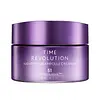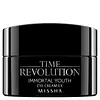What's inside
What's inside
 Key Ingredients
Key Ingredients

 Benefits
Benefits

 Concerns
Concerns

 Ingredients Side-by-side
Ingredients Side-by-side

Bifida Ferment Lysate
Skin ConditioningGlycerin
HumectantMethylpropanediol
SolventCyclohexasiloxane
EmollientHydrogenated Polyisobutene
EmollientCaprylic/Capric Triglyceride
MaskingTriethylhexanoin
MaskingNiacinamide
SmoothingCetearyl Alcohol
EmollientWater
Skin ConditioningDimethicone
EmollientStearyl Alcohol
EmollientTrehalose
HumectantCentella Asiatica Extract
CleansingFicus Carica Fruit Extract
HumectantDioscorea Japonica Root Extract
Skin ConditioningOryza Sativa Extract
AbsorbentPhellodendron Amurense Bark Extract
Skin ConditioningLactobacillus/Punica Granatum Fruit Ferment Extract
Skin ConditioningLactobacillus/Soybean Ferment Extract
Skin ConditioningMonascus Extract
Skin ConditioningSolanum Melongena Fruit Extract
Skin ConditioningDaucus Carota Sativa Root Extract
Skin ConditioningVaccinium Angustifolium Fruit Extract
Skin ProtectingBeta Vulgaris Root Extract
Skin ConditioningBrassica Oleracea Capitata Leaf Extract
Skin ConditioningCitrus Aurantium Bergamia Fruit Oil
MaskingPelargonium Graveolens Flower Oil
MaskingHydrogenated Lecithin
EmulsifyingCamellia Sinensis Seed Oil
HumectantCamellia Japonica Seed Oil
EmollientArgania Spinosa Kernel Oil
EmollientOlea Europaea Fruit Oil
MaskingMacadamia Integrifolia Seed Oil
Skin ConditioningHelianthus Annuus Seed Oil
EmollientSimmondsia Chinensis Seed Oil
EmollientLavandula Angustifolia Oil
MaskingCitrus Aurantium Dulcis Peel Oil
MaskingAnthemis Nobilis Flower Oil
MaskingSantalum Album Oil
MaskingBeeswax
Emulsion StabilisingCetyl Alcohol
EmollientCetearyl Glucoside
EmulsifyingVinyldimethicone
Polyglyceryl-2 Triisostearate
EmulsifyingCetearyl Olivate
Sorbitan Olivate
EmulsifyingGlyceryl Stearate
EmollientPalmitic Acid
EmollientStearic Acid
CleansingAmmonium Acryloyldimethyltaurate/Vp Copolymer
Glycosyl Trehalose
Emulsion StabilisingXanthan Gum
EmulsifyingHydrogenated Starch Hydrolysate
HumectantAdenosine
Skin ConditioningRaffinose
Skin ConditioningGlyceryl Polymethacrylate
Dextrin
AbsorbentTheobroma Cacao Shell Powder
AbrasiveLactobacillus Ferment
Skin ConditioningLactococcus Ferment Lysate
Skin ConditioningLactobacillus/Acerola Cherry Ferment
Skin ProtectingLactobacillus Ferment Lysate
Skin ConditioningLactococcus Ferment
Skin ConditioningLeuconostoc/Radish Root Ferment Filtrate
AntimicrobialDisodium EDTA
Lecithin
EmollientGlucose
HumectantPolyquaternium-51
Skin ConditioningCeramide NP
Skin ConditioningMyristic Acid
CleansingSucrose Distearate
EmollientDipropylene Glycol
HumectantBiosaccharide Gum-1
HumectantSaccharomyces Ferment
Skin ConditioningPhytosteryl/Isostearyl/Cetyl/Stearyl/Behenyl Dimer Dilinoleate
Skin ConditioningCeramide AP
Skin Conditioning1,2-Hexanediol
Skin ConditioningHydroxyacetophenone
AntioxidantEthylhexylglycerin
Skin ConditioningLimonene
PerfumingCitronellol
PerfumingGeraniol
PerfumingLinalool
PerfumingBifida Ferment Lysate, Glycerin, Methylpropanediol, Cyclohexasiloxane, Hydrogenated Polyisobutene, Caprylic/Capric Triglyceride, Triethylhexanoin, Niacinamide, Cetearyl Alcohol, Water, Dimethicone, Stearyl Alcohol, Trehalose, Centella Asiatica Extract, Ficus Carica Fruit Extract, Dioscorea Japonica Root Extract, Oryza Sativa Extract, Phellodendron Amurense Bark Extract, Lactobacillus/Punica Granatum Fruit Ferment Extract, Lactobacillus/Soybean Ferment Extract, Monascus Extract, Solanum Melongena Fruit Extract, Daucus Carota Sativa Root Extract, Vaccinium Angustifolium Fruit Extract, Beta Vulgaris Root Extract, Brassica Oleracea Capitata Leaf Extract, Citrus Aurantium Bergamia Fruit Oil, Pelargonium Graveolens Flower Oil, Hydrogenated Lecithin, Camellia Sinensis Seed Oil, Camellia Japonica Seed Oil, Argania Spinosa Kernel Oil, Olea Europaea Fruit Oil, Macadamia Integrifolia Seed Oil, Helianthus Annuus Seed Oil, Simmondsia Chinensis Seed Oil, Lavandula Angustifolia Oil, Citrus Aurantium Dulcis Peel Oil, Anthemis Nobilis Flower Oil, Santalum Album Oil, Beeswax, Cetyl Alcohol, Cetearyl Glucoside, Vinyldimethicone, Polyglyceryl-2 Triisostearate, Cetearyl Olivate, Sorbitan Olivate, Glyceryl Stearate, Palmitic Acid, Stearic Acid, Ammonium Acryloyldimethyltaurate/Vp Copolymer, Glycosyl Trehalose, Xanthan Gum, Hydrogenated Starch Hydrolysate, Adenosine, Raffinose, Glyceryl Polymethacrylate, Dextrin, Theobroma Cacao Shell Powder, Lactobacillus Ferment, Lactococcus Ferment Lysate, Lactobacillus/Acerola Cherry Ferment, Lactobacillus Ferment Lysate, Lactococcus Ferment, Leuconostoc/Radish Root Ferment Filtrate, Disodium EDTA, Lecithin, Glucose, Polyquaternium-51, Ceramide NP, Myristic Acid, Sucrose Distearate, Dipropylene Glycol, Biosaccharide Gum-1, Saccharomyces Ferment, Phytosteryl/Isostearyl/Cetyl/Stearyl/Behenyl Dimer Dilinoleate, Ceramide AP, 1,2-Hexanediol, Hydroxyacetophenone, Ethylhexylglycerin, Limonene, Citronellol, Geraniol, Linalool
Betula Alba Juice
AstringentCyclomethicone
EmollientDimethicone/Vinyl Dimethicone Crosspolymer
Skin ConditioningGlycerin
HumectantButylene Glycol
HumectantDipropylene Glycol
HumectantNiacinamide
SmoothingSilica
Abrasive1,2-Hexanediol
Skin ConditioningAcetyl Tetrapeptide-5
HumectantSh-Decapeptide-9
Skin ConditioningSodium Cocoyl Alaninate
Dimethicone
EmollientHydrogenated Lecithin
EmulsifyingCassia Alata Leaf Extract
AstringentAdenosine
Skin ConditioningHydrolyzed Myrtus Communis Leaf Extract
Skin ProtectingResveratrol
AntioxidantXanthophylls
Skin ConditioningAlgin
MaskingPolyglutamic Acid
Skin ConditioningTitanium Dioxide
Cosmetic ColorantPhenoxyethanol
PreservativeBetula Alba Juice, Cyclomethicone, Dimethicone/Vinyl Dimethicone Crosspolymer, Glycerin, Butylene Glycol, Dipropylene Glycol, Niacinamide, Silica, 1,2-Hexanediol, Acetyl Tetrapeptide-5, Sh-Decapeptide-9, Sodium Cocoyl Alaninate, Dimethicone, Hydrogenated Lecithin, Cassia Alata Leaf Extract, Adenosine, Hydrolyzed Myrtus Communis Leaf Extract, Resveratrol, Xanthophylls, Algin, Polyglutamic Acid, Titanium Dioxide, Phenoxyethanol
Ingredients Explained
These ingredients are found in both products.
Ingredients higher up in an ingredient list are typically present in a larger amount.
1,2-Hexanediol is a synthetic liquid and another multi-functional powerhouse.
It is a:
- Humectant, drawing moisture into the skin
- Emollient, helping to soften skin
- Solvent, dispersing and stabilizing formulas
- Preservative booster, enhancing the antimicrobial activity of other preservatives
Adenosine is in every living organism. It is one of four components in nucleic acids that helps store our DNA.
Adenosine has many benefits when used. These benefits include hydrating the skin, smoothing skin, and reducing wrinkles. Once applied, adenosine increases collagen production. It also helps with improving firmness and tissue repair.
Studies have found adenosine may also help with wound healing.
In skincare products, Adenosine is usually derived from yeast.
Learn more about AdenosineDimethicone is a type of synthetic silicone created from natural materials such as quartz.
What it does:
Dimethicone comes in different viscosities:
Depending on the viscosity, dimethicone has different properties.
Ingredients lists don't always show which type is used, so we recommend reaching out to the brand if you have questions about the viscosity.
This ingredient is unlikely to cause irritation because it does not get absorbed into skin. However, people with silicone allergies should be careful about using this ingredient.
Note: Dimethicone may contribute to pilling. This is because it is not oil or water soluble, so pilling may occur when layered with products. When mixed with heavy oils in a formula, the outcome is also quite greasy.
Learn more about DimethiconeDipropylene Glycol is a synthetically created humectant, stabilizer, and solvent.
This ingredient helps:
Dipropylene glycol is technically an alcohol, but it belongs to the glycol family (often considered part of the ‘good’ alcohols). This means it is hydrating and gentle on skin unlike drying solvent alcohols like denatured alcohol.
As a masking agent, Dipropylene Glycol can be used to cover the smell of other ingredients. However, it does not have a scent.
Studies show Dipropylene Glycol is considered safe to use in skincare.
Learn more about Dipropylene GlycolGlycerin is already naturally found in your skin. It helps moisturize and protect your skin.
A study from 2016 found glycerin to be more effective as a humectant than AHAs and hyaluronic acid.
As a humectant, it helps the skin stay hydrated by pulling moisture to your skin. The low molecular weight of glycerin allows it to pull moisture into the deeper layers of your skin.
Hydrated skin improves your skin barrier; Your skin barrier helps protect against irritants and bacteria.
Glycerin has also been found to have antimicrobial and antiviral properties. Due to these properties, glycerin is often used in wound and burn treatments.
In cosmetics, glycerin is usually derived from plants such as soybean or palm. However, it can also be sourced from animals, such as tallow or animal fat.
This ingredient is organic, colorless, odorless, and non-toxic.
Glycerin is the name for this ingredient in American English. British English uses Glycerol/Glycerine.
Learn more about GlycerinHydrogenated Lecithin is created from the hydrogenation of lecithin (a group of phospholipids). Hydrogenation is a chemical reaction between hydrogen and another element.
This ingredient is an emollient and emulsifier. As an emollient, it helps soften skin by trapping moisture within. As an emulsifier, it prevents oil and water ingredients from separating.
Niacinamide is a multitasking form of vitamin B3 that strengthens the skin barrier, reduces pores and dark spots, regulates oil, and improves signs of aging.
And the best part? It's gentle and well-tolerated by most skin types, including sensitive and reactive skin.
You might have heard of "niacin flush", or the reddening of skin that causes itchiness. Niacinamide has not been found to cause this.
In very rare cases, some individuals may not be able to tolerate niacinamide at all or experience an allergic reaction to it.
If you are experiencing flaking, irritation, and dryness with this ingredient, be sure to double check all your products as this ingredient can be found in all categories of skincare.
When incorporating niacinamide into your routine, look out for concentration amounts. Typically, 5% niacinamide provides benefits such as fading dark spots. However, if you have sensitive skin, it is better to begin with a smaller concentration.
When you apply niacinamide to your skin, your body converts it into nicotinamide adenine dinucleotide (NAD). NAD is an essential coenzyme that is already found in your cells as "fuel" and powers countless biological processes.
In your skin, NAD helps repair cell damage, produce new healthy cells, support collagen production, strengthen the skin barrier, and fight environmental stressors (like UV and pollution).
Our natural NAD levels start to decline with age, leading to slower skin repair, visible aging, and a weaker skin barrier. By providing your skin niacinamide, you're recharging your skin's NAD levels. This leads to stronger, healthier, and younger looking skin.
Another name for vitamin B3 is nicotinamide. This vitamin is water-soluble and our bodies don't store it. We obtain Vitamin B3 from either food or skincare. Meat, fish, wheat, yeast, and leafy greens contain vitamin B3.
The type of niacinamide used in skincare is synthetically created.
Learn more about Niacinamide